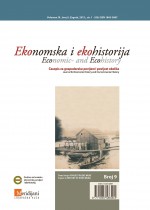POSLJEDICE ERUPCIJE VULKANA HUAYNAPUTINA GODINE 1600. NA HRVATSKE ZEMLJE
THE CONSEQUENCES OF THE HUAYNAPUTINA VOLCANO ERUPTION OF 1600 ON THE CROATIAN LANDS
Author(s): Krešimir KužićSubject(s): History
Published by: Društvo za hrvatsku ekonomsku povijest i ekohistoriju - Izdavačka kuća Meridijani
Keywords: volcano eruption; disasters; famine; plague; war; Croatia; Bosnia
Summary/Abstract: The eruption of the Huaynaputina volcano in southeast Peru on 18 February 1600 caused a massive amount of sulphur gases to inject into the stratosphere. As a result, an aerosol developed which shrouded the Northern hemisphere and subsequently caused climate anomalies which, in milder or more severe forms, affected the majority of Europe, including Croatian regions. The following 4 to 6 years saw extremely cold winters with heavy snowfall, periods of drought, extremely hot weather, as well as numerous severe hailstorms. Although the data found in chronicles from Croatian regions are scarce, the knowledge of circumstances can be completed by reading military logbooks and other correspondence. The data derived from ice core indicators and dendroclimatic indicators of three tree rings, according to which the average temperature dropped by 0.8 ºC, provide plausible clues in reconstructing the effects on the wider area. The chronicler which recorded the most valuable information (until 1612) was don Vicenc Frljanić of Boljun, Istria; the severe cold weather of 29 November 1600 is particularly worth mentioning in that context. A letter from Senj mentions a twenty-day violent bora appearing in September and October of 1601. It is known that somewhat later Osijek experienced heavy snowfall, and subsequently there were mentions of hailstorms and droughts as well as recurring harsh winters in other areas. The aforementioned phenomena are to be considered within the context of the so-called Little Ice Age which, according to some, lasted from 1450 to 1850 with certain fluctuations. The climate phenomena caused by the Huaynaputina vulcano eruption were just part of a longer period of adverse weather conditions. The consequent shortage of cereal stock led to the occurrence of famine in some parts, which was solved by procuring wheat from other regions. The coastal areas from Istria to Dubrovnik generally suffered from shortage of wheat, which is why it was imported by land from the nearer hinterland, that is, Herzegovina and Bosnia, or by sea from southern Italy and the Levant. Dubrovnik succeeded in achieving the highest level of care for the population, while other Dalmatian cities under Venetian rule often experienced problems with import due to military conflicts with the Ottomans. The plunders committed by the Ottoman army were the cause of the shortage which occurred in northern Croatia as well. Plague struck Split the hardest, taking the lives of almost 3,200 of the 4,223 inhabitants in 1607. The disease appeared in the Middle East and was transmitted via trading routes and by local military contingents hired by the Ottoman Empire to fight the Habsburgs in the area of Hungary. In eastern Bosnia and Sarajevo the disease spread as early as 1604, from where it entered Split due to trade, in spite of the existing lazaretto.
Journal: Ekonomska i ekohistorija - Časopis za gospodarsku povijest i povijest okoliša
- Issue Year: 2013
- Issue No: 9
- Page Range: 97-113
- Page Count: 17
- Language: Croatian

